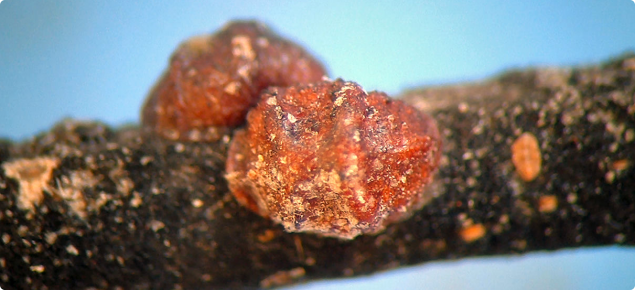Damage
- Black scales excrete a sugary substance known as honeydew, produced as a by-product of their feeding.
- Sooty mould fungi grow on top of the honeydew, coating leaves, twigs and fruit in a black powder.
- Sooty mould can interfere with plant photosynthesis, reducing tree vigour and yield, tainting the oil, increasing fruit washing costs at harvest, and higher spray costs.
- Severe infestations can cause early leaf-fall, die-back of the branches and even a lack of fruit for a few years.
Identification and developmental stages
There are two to three generations per year, depending on temperature and humidity.
In subtropical conditions where winters are milder, more generations are completed per year. Look for black scale on the leaves, twigs, branches and fruits. Identification of the correct developmental stage of black scale is crucial for chemical control. The immature stages — crawler and first instar — are most susceptible to insecticides.
- Eggs are laid under the body of the female and are 0.2‑0.3mm long. Initially pale orange in colour, they turn pink before hatching. Eyespots are visible within the eggs before they hatch as crawlers.
- Crawlers are the main dispersive stage, responsible for spread within and between olive groves. They can be dispersed passively such as by wind or on farm machinery, and actively, when the crawler wanders onto leaves and twigs. Although crawlers can wander for up to 36 hours, they usually settle within two to three hours. Most crawlers settle onto the mid-rib of the leaf, usually near the mother scale. Crawlers are light pink‑orange with black eyes and 0.2–0.3mm long.
- Once settled, crawlers shed their skin (moult) and become first instars. They are 0.6-0.75mm long and 0.2-0.35mm wide.
- Second instar. During this stage a longitudinal ridge begins to form along the middle of the scale. The body is pale brown with four dark brown patches,
0.6–0.8mm long and 0.3–0.4mm wide. - Third instar. Ridges are clearly present, with a light brown body that darkens with age, the dark patches are much bigger than the previous instar. They are
1–1.6mm long and 0.5–0.8mm wide. - The adult female is nearly circular, often with a ridged letter 'H' on its back. As the female approaches the egg-laying stage, the scales become dark, and mottled gray which is referred to as the 'rubber stage'. When egg laying commences the scale surface becomes smoother, darkening to black. Eggs are laid under the body of the female and she dies after laying eggs, although the body remains on the leaves or twigs.
Other scales
Other scales found on olives include parlatoria (Parlatoria oleae [Colvée]), red scale (Aonidiella aurantii), latania (Hemiberlesia lataniae), Ross’s black scale (Lindingaspis rossi) and circular black scale (Chrysomphalus aonidum). These are regarded as minor olive pests.


